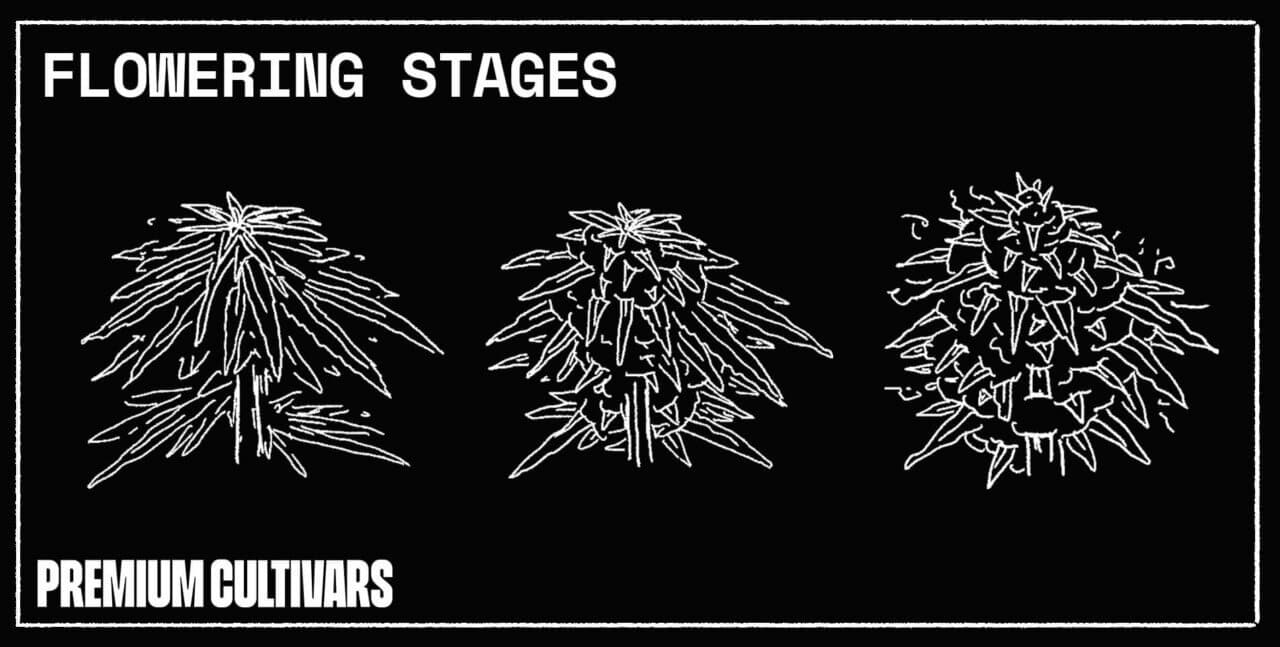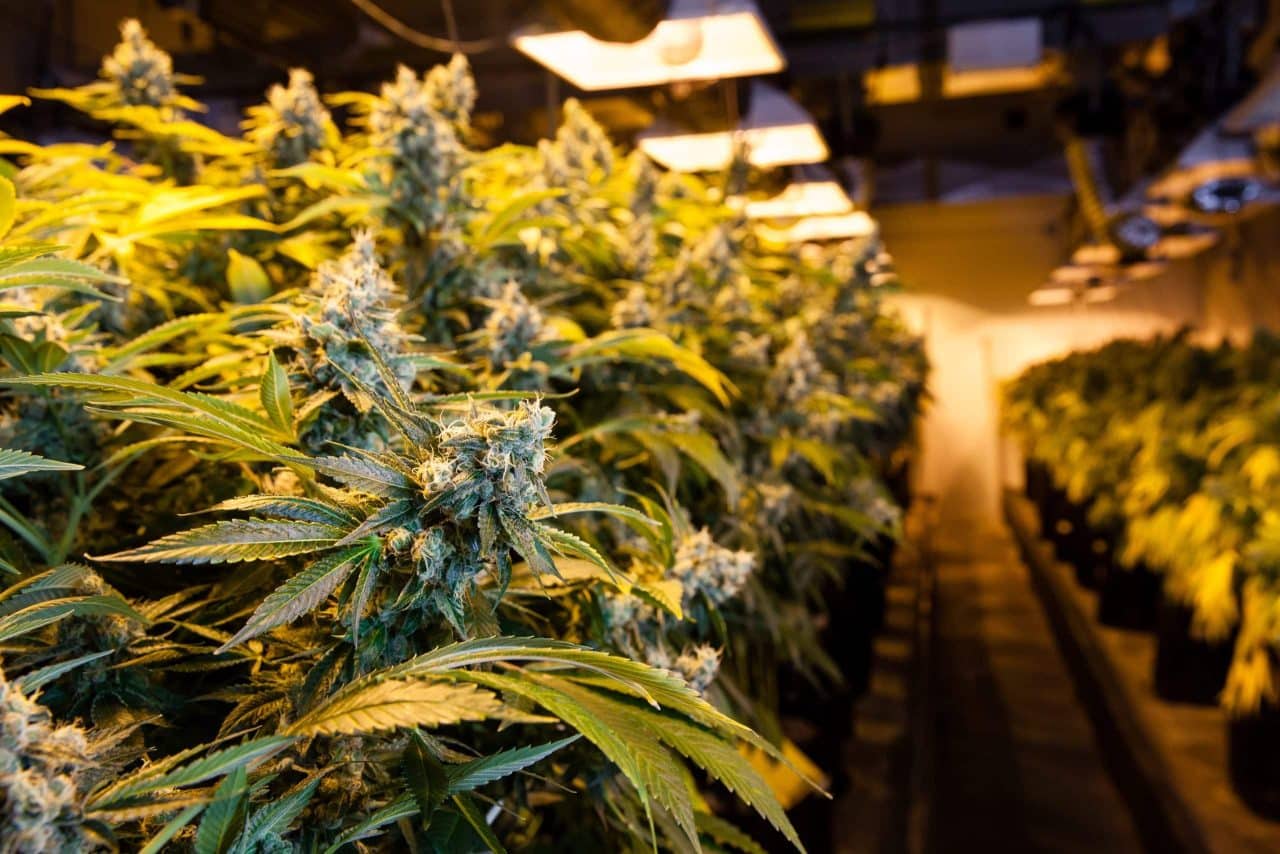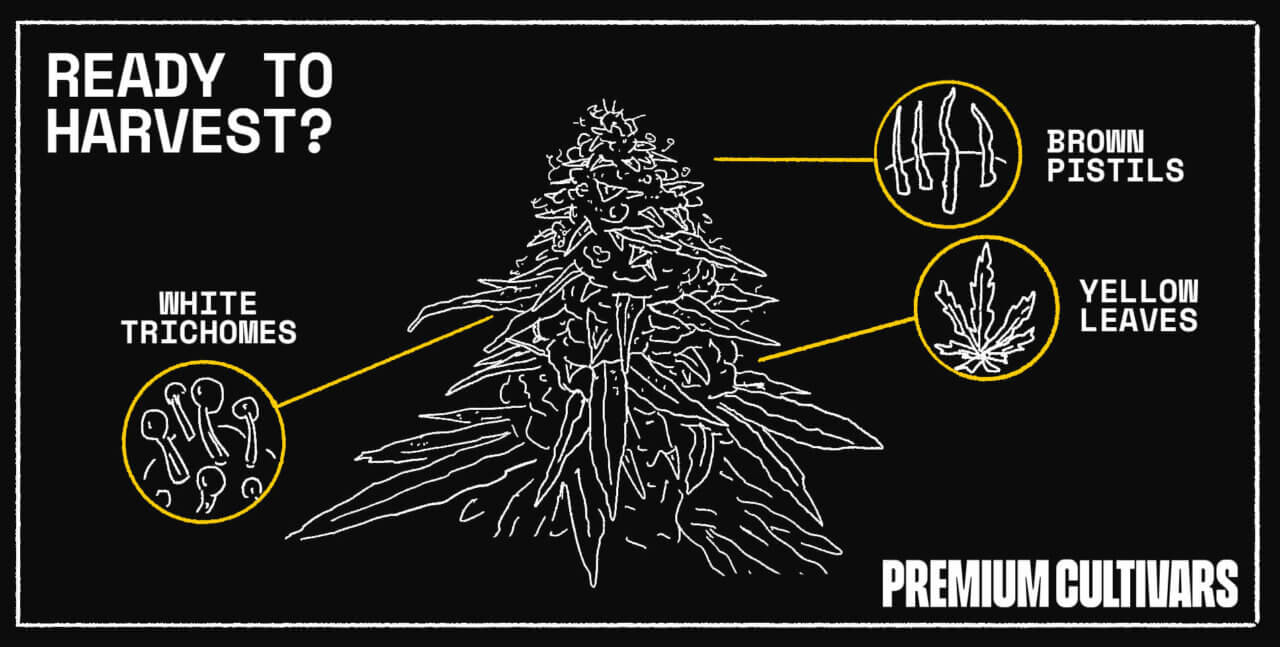Understanding the cannabis flowering phase can be tricky, but you can make this more natural with practice. Take your time to learn the basics and practice. This guide will teach you about cannabis flowering and describe the vital factors to consider so you can become a better grower. It will also go over each exciting milestone – harvesting, drying, and curing – and offer tips on how to make the most of this period to create potent buds and great yields.
Understanding the Cannabis Flowering Stage
The blooming stage is the time when the plant develops flowers or buds. Understanding the cannabis flowering process is critical for both novice and seasoned producers. It assists you in recognizing the indicators that your cannabis plants are about to blossom, allowing you to adapt your care routine accordingly.

Proper care is essential for boosting bud size, potency, and total production during this vital stage. You’ll be well-equipped to cultivate some wonderful cannabis if you understand the distinct stages of flowering, the specialized demands of your plants throughout this period, and ways to boost bud formation.
The Exciting Transformation: From Vegetative to Flowering
The blooming stage immediately follows the vegetative stage. During the vegetative stage, the cannabis plant develops swiftly and rapidly, acquiring much of its total height in the first few weeks of life. A lot happens at this moment. The vegetative stage is quick and productive, from the first few leaves poking their way above the earth to a gangly, thin cannabis plant. Vegetative development slows and finally stops as the plant enters the blooming stage since all energy is diverted into the formation of rich, sticky buds.
Unlocking the Secrets: How Cannabis Flowers Develop
Cannabis flowering is triggered by a hormonal plant reaction initiated by an increase in the length of its dark cycle. The flowering phase is induced by giving your cannabis plants at least 12 hours per day of complete darkness.

When the light cycle provides cannabis plants with longer hours of uninterrupted darkness, they enter the flowering stage. The plants will stop growing and instead put their energy into producing buds (flowers).
Nurturing the First Signs of Flowering
Contrary to popular belief, the cannabis blooming stage does not begin with the development of flowers. Flowering happens after a few weeks of growth. It has nothing to do with when you stimulate blooming. However, the cannabis blooming stage occurs when the plant detects a shift in light.
This is how it knows winter is on its way. Many individuals wrongly believe that this shift equals less light. An increase in the amount of continuous darkness assesses the shift. The plant will develop quickly when the strain’s darkness threshold is reached, increasing height and stretching. During the first two weeks of flowering, some weed plants may even double in height.
The Importance of Light and Lighting Cycles
To initiate and maintain blooming, expose your cannabis plants to a consistent 12/12 light cycle. This implies they have 12 hours of light and 12 hours of darkness daily. Use a HID light in the yellow or red spectrum for optimal output. Using this type of light will guarantee that your plants receive the optimal quantity of high-quality light. However, full-spectrum LED sets compete with these HID systems and provide comparable outcomes. You definitely won’t have this much control if you’re growing outside. As a result, ensure that your cannabis plants receive as much regular sunshine as possible. Furthermore, ensure they are positioned so the light evenly hits all plant sections.
Optimizing Temperature and Humidity for Flowering
Temperature
Though not required, it is ideal to lower your grow room’s day and night temperatures by roughly 2-3°C. This further mimics the transition from summer to fall that you attempt to convey with the change in light hours. Simpler growth may not be able to fine-tune temperature to such an extent. If this is the case, don’t worry; it won’t make a big impact. However, if you can make all of these minor adjustments, it can positively impact your harvest.
Humidity
Once the buds develop, the humidity in the growing environment should always be at most 50%. If this happens, it produces an ideal setting for bud rot. Furthermore, with this much moisture in the air, droplets on the ceiling are significantly more likely to develop, which might leak onto electrics and produce potentially disastrous difficulties. During this stage, you should strive for 40% RH.
Nutrients and Supplements for Healthy Flowering
Cannabis requires nitrogen, phosphorus, and potassium to thrive. During the blooming period, you’ll want to make sure your fertilizer is especially high in the latter two nutrients, as these are the ones cannabis plants need to produce buds. Nitrogen fertilizers should be cautiously used, especially after week 4 of blooming. Excess nitrogen can reduce plant resilience, attracting pests and diseases.

Consider using cal-mag additives sparingly since they have been shown to boost overall plant performance, particularly during the blooming stage. Again, don’t overdo it since this will result in nutrient burn. Remember to stop feeding 1-3 weeks before harvest to allow the cannabis plants to complete without having too many nutrients in their system.
The Critical Role of Pruning in Maximizing Flower Production
Prune your weed plants throughout the second month of their blooming cycle. You should have finished any low-stress training, and your weed plants’ development patterns should have stabilized. Some producers might try to supercrop at this stage, but it is not recommended since many plants will need more time to recuperate from the stress. Although it is not required, some gardeners like to prune to maximize the vegetative development of their plants. This is because it saves the plant energy and ensures that most light and nutrients are directed to the most promising buds. In addition, you shouldn’t cut too many leaves since your plant won’t regrow many of them. You also need them to absorb light and keep flowers growing.
Controlling Pests and Diseases During the Flowering Stage
Here are some practices for preventing and managing pests and diseases during the flowering stage of cannabis cultivation:
- Control the humidity concentrations in your grow tent or room. Keep a relative humidity of around 50%, particularly during the flowering stage.
- Provide good air circulation. Ensure your grow room has good ventilation.
- Use resistant cannabis strains. Choose cannabis strains that are resistant or tolerant to common pests and illnesses.
- Monitor your weed plants regularly for signs of pests and diseases.
Enhancing Aroma and Flavor: Terpenes in Cannabis Flowers
Enhancing the aroma and flavor of cannabis during the flowering phase involves several factors:
- Environmental factors: It’s crucial to create an ideal environment for your cannabis plant during the flowering stage. This includes managing light, temperature, humidity, and nutrient requirements.
- Light cycle: The perfect light cycle for cannabis flowering is 12 hours of light and 12 hours of darkness. This mimics the natural changes in day length that cannabis strains have adapted to in their native environments.
- Nutrients: Providing essential nutrients can enhance the aroma, flavor, and potency of your cannabis buds. Most farmers usually experience increased resin production and higher yields using high-quality blooming nutrients.
- Strain selection: Start with naturally flavorsome strains. The age-old procedure of selective breeding has allowed seed banks to develop tailored terpene profiles that suit every possible taste.
Monitoring Trichome Development: The Key to Harvest Time
Trichomes are the microscopic, crystal-like structures that coat cannabis plants’ buds and leaves. The cannabinoids and terpenes accountable for the plant’s effects and scent are found in these trichomes. The development of trichomes is a reliable approach for measuring harvest readiness. Examine the buds’ trichomes on the buds using a magnifying instrument, such as a jeweler’s loupe or a digital microscope.
The trichomes will seem transparent throughout the early stages of blossoming. The trichomes will turn milky white as the plant grows.
- Clear: Trichomes begin to develop before the blooming cycle. During the early stages of growth, they seem transparent or translucent. Trichomes begin actively manufacturing cannabis resin once the entire plant has finished blooming. However, the quantities of cannabinoids and terpenes inside these trichomes are currently being optimized. Clear trichomes suggest that the cannabis plant’s cannabinoid levels are not yet optimal. Rushing the harvesting procedure at this stage will result in a loss of potential production, lowering the overall quality of the buds.
- Milky or cloudy: As the cannabis plant matures, the trichomes change from clear to milky or foggy in appearance. This stage denotes maximal cannabinoid production, and the plant is approaching its ideal harvest window. Many cultivators believe this stage is the best time to harvest (when trichome ripeness and cannabinoid levels are at their highest). Milky or foggy trichomes signify a good mix of intensity and flavor, which is great for those looking for a well-rounded cannabis experience. Most trichome glands should be milky or murky when inspecting trichomes, with just a small part remaining clear. Starting the harvesting procedure at this point provides a powerful and tasty end product with an ideal combination of cannabinoids and terpenes.
- Amber: The cloudy trichomes progressively become amber or brownish in the last stage of trichome growth. The appearance of amber or brownish trichomes implies increased cannabis breakdown. Trichomes that have become amber indicate that the plant has reached its optimal maturity for users wanting high cannabinoid levels. When waiting for trichomes to become amber, caution is vital because it might reduce their overall potency and flavor. Harvesting is preferable when the trichomes are largely milky with hardly a trace of amber.
Harvesting at the Right Moment: How to Determine Ripeness
When it comes to harvesting, there are a few indicators to watch for. The strain you’re cultivating will decide when you may harvest, with a normal window of 7 days. With a few exceptions, the pistils normally turn orange as harvest approaches. This signifies that your plant is no longer producing new buds.

As the cannabinoid levels rise at this stage of the cannabis blooming cycle, the trichomes will change from clear to amber. During the cannabis flowering period, your plant is extremely sensitive. Watch your plants in the final few weeks to minimize bud rot and other problems. Your blossoming buds will grow heavy at this point, so make sure you have enough support.
The Art of Properly Drying and Curing Cannabis Buds
Proper drying and curing are essential for keeping your weed plants’ flavor, fragrance, and potency. After harvesting, hang the branches in a dark, cool, well-ventilated place for 7-14 days. Growers should ensure the humidity is at 50% and the temperature is between 15-21°C. Conversely, curing entails preserving the dried buds in airtight containers, like glass jars, for a few weeks. This method distributes the residual moisture uniformly and improves the weed’s overall quality and flavor.
Post-Harvest Techniques for Long-Term Storage
Some of the most important parameters influencing the quality and durability of cannabis buds are:
- Moisture content: Cannabis buds should be dried and cured adequately to avoid mold and microbial development. The optimal moisture level for cannabis preservation is between 55 and 62%.
- Temperature: Keep your buds in a cool and dark place (away from direct sun and other heat sources). This is because high temperatures can destroy cannabinoids and terpenes while increasing the danger of mold and insect infestation.
- Light: Keep your cannabis buds in dark-colored or opaque containers to protect them from light. This is because light can degrade the cannabinoids and terpenes and alter the color and appearance of your weed.
- Oxygen: Store their buds in airtight containers to minimize exposure to oxygen. This is because oxygen can oxidize the cannabinoids and terpenes of your cannabis, lowering the potency and flavor.
Common Mistakes to Avoid During the Flowering Stage
Common mistakes during the cannabis flowering stage include:
- Overdoing weed nutrients and pH concentrations. Growers should keep the pH steady during the flowering phase. The ideal pH level in the soil is between 6.0 and 7.0, while in coco and hydro grows, it should be close to 5.8.
- Improper lighting setup for indoor cultivators. During the flowering stage, they need 12 hours of bright light and 12 hours of uninterrupted darkness to trigger and maintain bud production. They also need a light source that provides enough light penetration and spectrum to reach all the buds and enhance their quality.
- Male plants pollinate females. Male plants produce pollen sacs that can fertilize females, causing them to generate seeds instead of buds. This can cause reduced harvest yield and quality and introduce unwanted genetics to your plant.
- Underestimating the dangers of humidity and mold. Mold can grow on your weed buds due to high humidity, poor ventilation, or lack of airflow in your grow space. Mold can appear as white, gray, or black fuzz, spots, or webbing on your buds or stems. It can also cause your buds to smell musty, sour, or rotten.
- Cannabis odor leaking from your grow tent or room: Cannabis plants generate a strong and distinctive smell that can attract unwanted attention or cause issues with your neighbors or authorities. The smell becomes even more intense and noticeable during flowering, mostly as the buds mature and ripen.
Troubleshooting Flowering Issues: Tips for Success
Here are the best flowering stage tips for cannabis:
- Remove excess foliation: Some professionals clip their plants’ leaves at this phase (defoliation) so that their plants can concentrate on bud growth. Make careful to leave enough leaves to sustain the health of your plant! The leaves fuel the plant’s system and thus bud development.
- Support heavy weed buds to maintain light exposure: If your buds are too heavy for your plant, consider holding them up and close to the light.
- Prevent nutrient burn: Nutrient burn might affect your plant’s health. Avoid overfeeding your plant with nutrients.
- Proper airflow: Space all cannabis plants far enough apart to allow for optimal airflow between them. This reduces hot spots from lights and the spread of powdery mildew while increasing carbon dioxide and oxygen dispersion.
- Only clip dead leaves and branches: It may be tempting to prune large branches, but your plants require all the energy and health they can receive right now. Alternatively, you can bend and bind the plants to make a more horizontal table-like form rather than a Christmas tree shape.
- Maintain humidity around 45%: When maintaining humidity throughout the flowering stage, aim for 45% humidity in your grow room. With humidity above 50%, you face the danger of powdery mildew on your buds during the flowering period.
Exploring Different Harvesting Techniques and Methods
Cannabis plants are harvested using two methods: wet trimming and dry trimming. Both approaches have pros and disadvantages.
- Wet trimming is cutting off the fan leaves when the plant is still young and hanging the branches to dry. Some growers prefer wet cutting because it is faster and simpler to manage. However, this procedure can cause the buds to dry out rapidly, impacting the overall flavor and fragrance.
- Dry trimming involves hanging the entire cannabis plant or branch to dry before removing the leaves. Dry trimming is recognized to maintain fragrance and flavor better, although it is more labor-intensive and time-consuming.
The Importance of Timing: Planning for a Successful Harvest
Knowing when to harvest cannabis is essential for producing potent buds. Combine your strain’s estimated blooming time with its visual characteristics. The indicators of flowering completion include brown, curled pistils and opaque clarity in trichomes. These characteristics ensure you collect buds with the maximum concentration of cannabinoids and terpenes.
The post Flowering Cannabis – From the First Signs of the Flowering Stage Until Harvest appeared first on Premium Cultivars.



